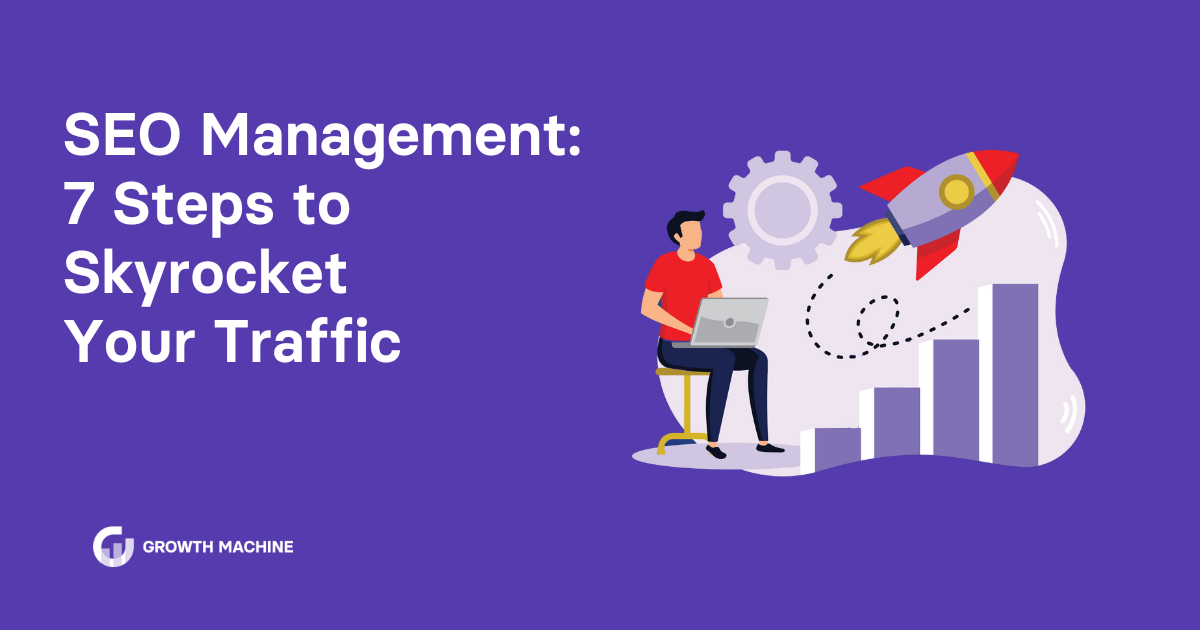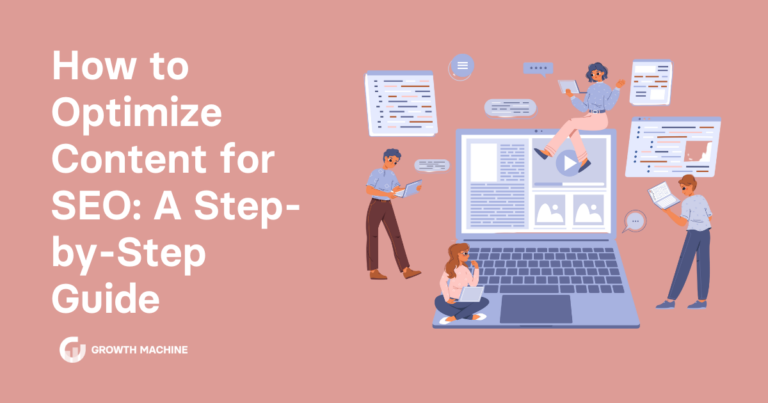SEO Management: 7 Steps to Skyrocket Your Traffic
As a digital marketing professional, you’ve no doubt had your eye on SEO, or search engine optimization. But while many marketers may have a vague idea of how SEO works, how many of them can say that they truly understand the intricacies of SEO management?
To put things into perspective, there are more than 80 billion Google searches conducted every single month — that’s a lot of potential visibility for your business. In order to get those eyes on your content and ultimately attract more users who are ready to convert, nothing beats a stellar SEO strategy.
This comprehensive guide will help you navigate the complex maze of SEO, understand the value of strategic SEO management, and share the most up-to-date techniques and tools you can use in your content marketing. Let’s dive in!
What Is SEO and How Does It Work?
Search engine optimization (SEO) is the process of optimizing your website content so search engines like Google will associate your content with specific search terms or keywords. The goal of SEO is ultimately to increase visibility in organic (non-paid) search engine results, drawing more organic traffic and ensuring a more seamless user experience.
Sounds great in theory. But how does it actually work and what steps do you need to take when creating content for your website?
Essentially, search engines use a series of calculations or predictions called algorithms to rank websites. These algorithms consider factors like the content’s quality, backlinks, site loading speed, and more. By accounting for these factors in your content creation, you’re essentially telling search engines that your site deserves those top rankings for specific keywords.
The 5 Key Components of SEO
SEO is a continuously evolving field. There are many nuances to it, which makes it tough to know where to even begin.
To make it a little easier to wrap our heads around, let’s distill it down into five essential components that form the foundation of any effective SEO strategy.
1. User-Focused Content
Content is the heart of any SEO strategy. After all, it’s what users are seeking and what search engines are interpreting. When it comes to creating high-quality content that users will click on, you need to consider:
- Depth: Your content should be long and detailed enough to be informative and add value to readers.
- Originality: This requires you to add something new to the conversation, rather than simply recycling your competitors’ ideas.
- Relevancy: Your blog posts should address popular search queries in your industry and closely match user intent.
- Frequency: The businesses who dominate the search rankings know that you need to publish often and regularly refresh older pieces of content.
- Multimedia: Include things like images, videos, and infographics to enhance reader understanding and encourage social media shares.
2. On-Page SEO
To rank higher in search results and attract more qualified traffic, you need to ensure that you’re optimizing individual pages of your website. On-page SEO includes the following:
- Using relevant keywords (in titles, headers, meta descriptions, and the content you create).
- Internal linking and URL structure. Both users and search engines should be able to use links to discover other relevant content on your site.
- Image optimization, including image size and compression where needed, and including alt text to help search engines decipher what the image is all about (this is also crucial for accessibility).
3. Off-Page SEO
These are the external factors that influence your web page’s search ranking. Mainly, we’re referring to backlinks, specifically, the quality and quantity of links from reputable sources. Off-page SEO can also include things like social media shares and brand mentions.
To brush up on your backlink outreach strategy, check out our guide on how to secure quality backlinks.
4. Technical SEO
As the name suggests, this area of SEO can be quite intricate and complex. The goal of technical SEO is to ensure that search engines can crawl and index your website without any issues. It encompasses elements like:
- Website load speed and performance
- Mobile friendliness and responsiveness
- XML sitemaps (a file that lists your website’s essential pages to ensure Google can find and crawl them)
- Structured data (the way data or content is grouped or structured on a certain page)
- Security of your website (HTTPS)
5. Local SEO
Last but certainly not least, local SEO is designed for businesses who have a physical presence, such as a brick and mortar store, or offer services within a specific geographic area.
Local SEO is critical if you want your business to appear in local search results and Google Maps listings. Key ranking factors include:
- Claiming and optimizing your Google My Business listing with key information such as your business name, address, and phone number (NAP).
- Customer reviews (gathering and responding to them).
- Building links from local sources, such as local websites, newspapers, influencers, and other organizations.
What Is SEO Management?
In general, SEO management is a systematic approach to optimizing a business’s website and online content, with the goal of improving a website’s search engine rankings.
SEO management is multifaceted and requires many different forms of expertise. For example, just because someone is a great content writer, it doesn’t mean that they have a thorough understanding of technical SEO. Either way, the wider the range of knowledge and expertise you can bring to the table, the more likely you are to succeed.
Just like Rome wasn’t built in a day, great SEO doesn’t happen overnight—or even in a few weeks. It requires a strategic, step-by-step plan that addresses each area of the five components of SEO. Ensuring that all parts of your SEO are working in harmony will give you the best shot at boosting those organic search rankings and bringing more traffic to your website.
7 Ways Level Up Your SEO Management
Whether you’re ready to tackle it with your internal marketing team or you’re looking to outsource to an experienced SEO agency, here’s what you need to know to improve your website’s search rankings.
1. Start With Your Business Goals
Effective SEO management is inextricably linked to your business goals. Your SEO strategy should connect to certain business objectives, such as:
- Increasing product sales through keyword research that identifies product-specific keywords, then including those keywords in product pages.
- Establishing a brand presence in a new market or segment by targeting industry-specific keywords or producing blog posts that address common questions or challenges in that market.
- Acquiring new local leads for a business by optimizing service pages, creating value-driven content that demonstrates expertise in your industry, and incorporating local SEO tactics.
- Reducing customer acquisition costs by investing in long-term SEO strategies that bring steady traffic without spending thousands a month on paid ads. This can also include producing evergreen content, building a robust backlink profile, and ensuring that technical SEO is on point.
By starting out with your end goal in mind, you’ll be able to ensure that your efforts translate into tangible outcomes for your business.
2. Conduct Keyword Research
Before you even start writing content, you need to identify the words and phrases your target audience is using when searching online.
If you’re going in completely blind, we recommend using a tool like Google Keyword Planner, Semrush, or Ahrefs. These tools can help you better understand your audience intent, analyze keyword competitiveness and identify keyword opportunities for your business.
At Growth Machine, we focus on targeting long-tail keywords (3-4 phrases) in our SEO strategies. The reason for this is that they often have less competition and a clear search intent. Read more about it in our guide on how to find niche keywords in a saturated market!
3. Optimize Your Website Structure & User Experience
There’s nothing a search engine loves more than a well-structured website with an intuitive user experience.
If you’ve never stopped to consider your user experience, a great place to start is to ensure it’s mobile-friendly. After all, more than 50% of web traffic comes from mobile — having a site with high mobile performance isn’t just a nice-to-have, it’s imperative if you want to be seen online.
Google even has a free Mobile-Friendly Test to help you assess and improve your site’s mobile performance.
When it comes to website structure, you can draw on elements of technical SEO to make sure your site is optimized for search engine crawling and indexing. Generally, a technical SEO expert is your best bet, since they’ll understand the nuances required to do this in the backend of your site. If you’re determined to go solo, you’ll want to investigate things like:
- Site speed and performance
- Checking that your site is optimized for mobile
- Setting up XML sitemaps and robots.txt
- Checking and fixing crawl errors
- Implementing structured data markups
4. Create High-Quality Content That’s Optimized for SEO
By far, the best way to increase your search ranking is to deliver high-quality, relevant content that addresses your popular search queries.
There are several ways that you can optimize your content creation for SEO:
- Provide original content: Remember, your content should be original, as well as informative, and aim to provide thorough answers to specific questions or add valuable insights in a thought-provoking way.
- Check out the competition: Feeling uninspired with your content ideas? It never hurts to take a quick peek at what other websites or blogs in your industry are writing about, then see where you can add a unique point of view or additional insights based on your expertise.
- Updating your existing content: A little-known fact is that optimizing old, outdated content can actually improve your search performance. Revisit your older blog posts periodically to see if the content is still accurate, or if it requires a bit of a facelift to keep up with current trends and happenings.
- Repurpose evergreen content: Don’t forget to look for opportunities to repurpose your website content into other forms. Have an evergreen blog post that hasn’t seen any new traffic for a while? Recycle it into a social media graphic or a helpful infographic to breathe new life into it and watch your organic traffic grow!
At Growth Machine, creating optimized content for SEO is our bread and butter. Check out how we added 120,000+ monthly organic sessions for a sleep app through long-form blog content.
5. Build Off-Page SEO With Backlink Outreach
Quality backlinks from reputable websites in your industry are one of the best ways to boost your site’s credibility, both in the eyes of search engines and your target audience.
When it comes to link building, a good rule of thumb is to aim for quality over quantity. One good link from an authoritative site beats dozens of low-quality links any day.
Pro tip: A tool like Moz or Ahrefs can help you monitor your existing backlink performance, identify opportunities for new backlinks, and evaluate which backlink sources your competitors are using.
To elevate your backlink profile, you can engage in tactics such as guest blogging, influencer outreach, or cold emailing. Don’t forget to monitor your backlinks and remove broken or poor quality links to keep everything in tip top shape.
6. Monitor Your Performance
It’s difficult to know where to go if you don’t know where you’ve been. By continuously assessing your website’s SEO performance, you can spot opportunities for improvement and make adjustments where necessary.
Tools like Google Analytics can help you track key metrics, such as organic traffic, bounce rates, and conversions. Pay close attention to where traffic is coming from and where you’re losing people, as this could indicate an issue with your website’s structure or a lack of content quality.
Returning back to our trusty SEO tools, which include Ahrefs, Moz, and Semrush, you can use these to monitor your site’s ranking for specific keywords. Are your rankings improving week to week or month to month? If not, it may be a clear sign that something has to change.
7. Keep Up With SEO News
Effective SEO management requires you to constantly adapt to search engine algorithms and best practices. One of the best ways to do this is by following reputable news sources or blogs in the SEO industry, such as Google’s own blog, Moz, Yoast, or Growth Machine’s own blog. Since organizations like these operate in SEO daily, they’ll have the most up-to-date information to help you keep up with search algorithms.
Ready to See Effective SEO Management In Action?
Let’s face it — SEO is no walk in the park.
To ensure that your business remains visible and competitive online, staying on top of SEO is paramount. And that requires time, expertise, and most of all, continuous effort. From keyword research to monitoring ever-changing algorithms, your in-house team’s plate can fill up quickly.
That’s where Growth Machine comes in. Our dedicated team lives and breathes SEO. With comprehensive SEO management that’s tailored to your needs and industry, we can help you navigate the SEO maze so your marketing team can focus on what they do best: improving your business’s online presence.
So leave the content creation to the experts and watch your website climb the search engine results pages. Contact us today!







